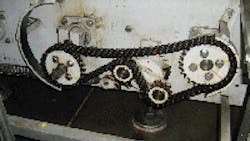Food manufacturer beefs up production with slip clutch
By incorporating a Polyclutch slip clutch from A&A Manufacturing Co., North Haven, Conn., into a conveyor drive mechanism, a prominent food manufacturer was able to increase the speed of a production line. Previously, the company was unable to run the line at its rated capacity because of difficulty in managing drive chain slack that affected indexing. The line handles rectangular packages weighing about 10 lb each. Each item moves down the conveyor on its narrow side, but as it is picked up and indexed, it needs to be moved along its length. The speed discrepancy caused by the difference in length and width contributed to the difficulty in managing slack in the conveyor’s reciprocating drive chain.
Problems in managing the slack limited the speed at which the line could be operated. A company technician explains, “The combined inertia of the chain and the product it is carrying cause the chain to overrun and build up slack. Then the dogs that pick up the product become out of position at higher speeds, which cause it to jam and drop the package.” He says a spring was included in the original design of the machine in an attempt to control the chain tension and eliminate the slack, but it was only marginally effective. “It would start to jam at about 25 or 26 units a minute, and we never were able to run the line at the design speed of 30 units per minute,” he continues.
Looking for a better way to manage the chain tension and increase the line speed, the company added a Polyclutch Slip-Aire pneumatic slip clutch. The spokesman fabricated an assembly to fit onto a four-bolt flange bearing at the stub end of the shaft on the driven side. He says, “As the assembly starts going faster, the clutch creates just enough drag to keep the inertia of the chain from overcoming the reciprocating part.”
A slip clutch consists of two assemblies: a cartridge and a housing. The cartridge is set-screwed or keyed to the input shaft. The housing may be either set screwed or keyed to the output shaft. It also can be attached to the output gear or pulley, with a bronze bearing to allow relative motion between the input shaft and the output gear or pulley. In a mechanical slip clutch, the torque level is controlled by compressing the clutch’s springs with the adjusting nut. The Polyclutch Slip-Aire used in this application is an air pressure-actuated version of the mechanical design. Air actuation allows the clutch to be used to engage/disengage, to vary the torque during operation, or to adjust the torque remotely at any time.
When the company first conceived the idea of using a slip clutch to manage the chain slack, the largest unit available actually was undersized for the application. The spokesman says that it worked as intended, but its service life was shorter than desired. Shortly thereafter, a larger size pneumatic Polyclutch became available and was installed successfully.
The line typically runs around the clock, five days per week, with occasional periods of 24/7 production. To maximize clutch performance and service life, a solenoid valve was added to turn the clutch off at line speeds of less than 22 units per minute. Air is also blown across the clutch to keep its temperature at optimum levels in the hot environment.
The clutches were installed on two crossover locations at opposite ends of the line, with the second one incorporating additional steel components to ensure optimum service life. The spokesman says the first unit was installed early in 2008. He anticipates a service life of 1-1/2 years under constant operation and says they are performing as expected to date. For more information, visit Polyclutch, a division of A&A Manufacturing.
